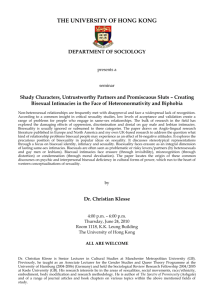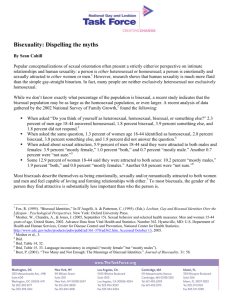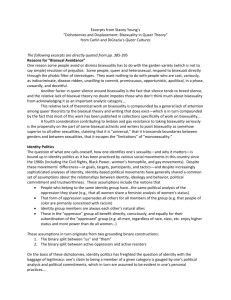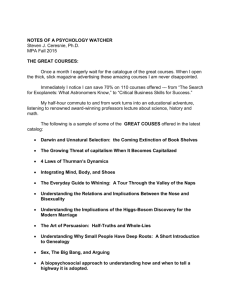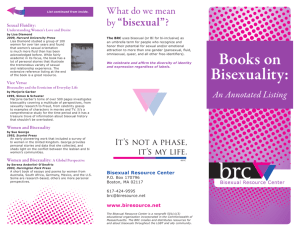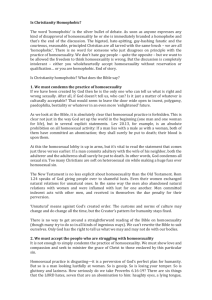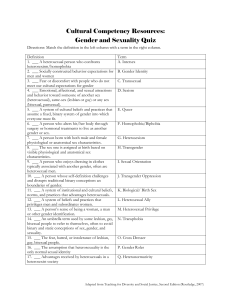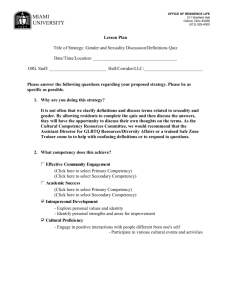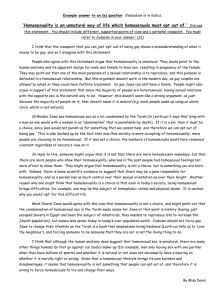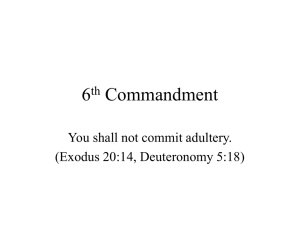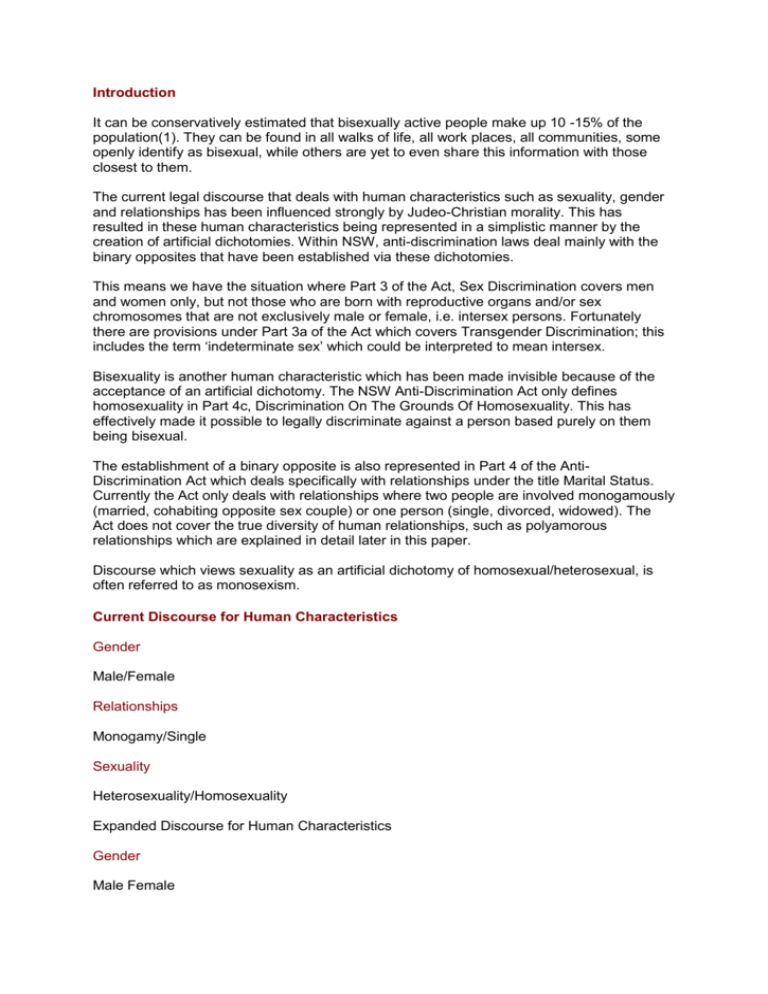
Introduction
It can be conservatively estimated that bisexually active people make up 10 -15% of the
population(1). They can be found in all walks of life, all work places, all communities, some
openly identify as bisexual, while others are yet to even share this information with those
closest to them.
The current legal discourse that deals with human characteristics such as sexuality, gender
and relationships has been influenced strongly by Judeo-Christian morality. This has
resulted in these human characteristics being represented in a simplistic manner by the
creation of artificial dichotomies. Within NSW, anti-discrimination laws deal mainly with the
binary opposites that have been established via these dichotomies.
This means we have the situation where Part 3 of the Act, Sex Discrimination covers men
and women only, but not those who are born with reproductive organs and/or sex
chromosomes that are not exclusively male or female, i.e. intersex persons. Fortunately
there are provisions under Part 3a of the Act which covers Transgender Discrimination; this
includes the term ‘indeterminate sex’ which could be interpreted to mean intersex.
Bisexuality is another human characteristic which has been made invisible because of the
acceptance of an artificial dichotomy. The NSW Anti-Discrimination Act only defines
homosexuality in Part 4c, Discrimination On The Grounds Of Homosexuality. This has
effectively made it possible to legally discriminate against a person based purely on them
being bisexual.
The establishment of a binary opposite is also represented in Part 4 of the AntiDiscrimination Act which deals specifically with relationships under the title Marital Status.
Currently the Act only deals with relationships where two people are involved monogamously
(married, cohabiting opposite sex couple) or one person (single, divorced, widowed). The
Act does not cover the true diversity of human relationships, such as polyamorous
relationships which are explained in detail later in this paper.
Discourse which views sexuality as an artificial dichotomy of homosexual/heterosexual, is
often referred to as monosexism.
Current Discourse for Human Characteristics
Gender
Male/Female
Relationships
Monogamy/Single
Sexuality
Heterosexuality/Homosexuality
Expanded Discourse for Human Characteristics
Gender
Male Female
Intersex
Relationships
Monogamy Single
Polyamory
Sexuality
Heterosexuality Homosexuality
Bisexuality
Bisexuality
At the moment NSW anti-discrimination law does not cover bisexuality, but it does explicitly
cover homosexuality. The failure to include bisexuality has often been ascribed to the fact
that bisexuals only suffer discrimination because of their existing or perceived homosexual
behaviour or characteristics. Closer examination leads to the conclusion that this is not the
only reason bisexuals face discrimination. In fact, it can be clearly shown that bisexuals are
often specifically the target of discrimination, but have no protection under the current Act.
The Legal and Policy Branch of the Anti-Discrimination Board wrote the following in
response to an inquiry about bisexual coverage under the current NSW Act. “A bisexual
person could also make a complaint of vilification if they are vilified because they are
presumed to be homosexual. However if they are not vilified on the basis of being presumed
to be homosexual but rather because they are bisexual, no recourse exists(3).”
In August 2000 the Anti-Discrimination Board put its position to the Attorney as follows “It is
the Board’s experience that discrimination and vilification against people on the ground of
their bisexuality is a reality and that this treatment has serious consequences for bisexual
people in their public life. In many cases the unfair treatment of bisexual people flows directly
from their bisexuality and not from presumed homosexuality. Accordingly the ground of
homosexuality is ineffective in addressing discrimination and vilification experienced by
bisexual people(3).”
A recent Australian general mental health survey called Path Through Life (2001) indicated
that bisexuals do experience discrimination because of their bisexuality and not just because
of their presumed homosexuality. The results showed that bisexuals generally have less
family support, less support from friends, and finish education earlier than either
homosexuals or heterosexuals(2). This is a typical feature of neglected communities, and
places a big question mark on the assertion by some that bisexuals are advantaged by
heterosexual privilege. True levels of workplace discrimination have not been surveyed, but
anecdotal evidence suggests it is common place.
At present, NSW is clearly out of step. Every other State and Territory in Australia includes
bisexuality as a ground of unlawful discrimination. In general other jurisdictions use one
overarching term such as “sexuality”, “sexual orientation” or “lawful sexual activity” and then
define that term to include bisexuality(3).
It seems that early successes in NSW have not been followed by thoughtful review. Sydney
may be the queer capital of the Southern Hemisphere, but it isn't a place where bisexual
human rights are being upheld.
Sexuality Anti-Discrimination Comparison Table (3)
State/Territory
Sexualities Covered
Attribute/Characteristic
ACT
Homosexual, Bisexual, Heterosexual
Sexuality
NSW
Homosexual
Homosexuality
NT
Homosexual, Bisexual, Heterosexual
Sexuality
Queensland
Homosexual, Bisexual, Heterosexual
Lawful Sexual Activity
SA
Homosexual, Bisexual, Heterosexual
Sexuality
Tasmania
Homosexual, Bisexual, Heterosexual
Sexual Orientation
Victoria
Homosexual, Bisexual, Heterosexual
Sexual Orientation
WA
Homosexual, Bisexual, Heterosexual
Sexual Orientation
Polyamory
A polyamorous relationship is one in which three or more people are sexually and
emotionally connected. It is possible that all the people involved may share the same level of
connection to each other, or one person may have two or more partners who are not
involved with each other.
Polyamory is not exclusive to the bisexual community; many heterosexual and homosexual
people form polyamorous relationships. However it should be noted that polyamorous
relationships are accepted and relatively common with in the bisexual community.
Polyamorous people who are parents are particularly concerned about the lack of AntiDiscrimination protection, as child protection services often see such relationships as
detrimental to the child’s welfare without examining the family circumstances thoroughly.
This group in particular is discriminated against when dealing with education and health
services for children.
Conclusion
Effective Anti-Discrimination laws must represent the true diversity of the Australian
population. By categorising sexuality, gender and relationship around artificial dichotomies
the current NSW Anti-Discrimination Act fails to protect a significant population. Writing laws
that protect specific characteristics or behaviours leads to exclusion, while the use of
generalised characteristics such as gender, sexuality and relationship would protect more of
the community (b).
End Note
a. The specific definitions of each State Act are explained below 3.
Victoria: “sexual orientation” is defined to mean homosexuality (including
lesbianism), bisexuality or heterosexuality.
Queensland: “lawful sexual activity” is not defined but would include
bisexuality.
South Australia: sexuality” is defined as heterosexuality, homosexuality,
bisexuality or transexuality.
Western Australia: “sexual orientation” will be defined as meaning “in
relation to a person heterosexuality, homosexuality, lesbianism or bisexuality
and includes heterosexuality, homosexuality, lesbianism or bisexuality
imputed to the person.”
Tasmania: “sexual orientation” is defined as heterosexuality, homosexuality,
bisexuality, transexuality.
Australian Capital Territory: “sexuality” means heterosexuality,
homosexuality (including lesbianism) or bisexuality.
Northern Territory: “sexuality” means the sexual characteristics or imputed
sexual characteristics of heterosexuality, homosexuality, bisexuality or
transexuality.
b. Minority groups could be protected by specific provisions to address the prejudices
that may be present in the broader community.
References
1. Kinsey estimated as high as 37% based on behavioural sets.
Fritz Klein, Males 30-45% Females 15-35%.
Margaret Mead estimated greater than 50% (behavioural sets).
Bell/Weinberg, 33% bisexual behaviour, 40% bisexual desire.
Weinberg/Williams 49.4% of all Americans.
2. Anthony F Jorm, DSc, Ailsa E. Korten, BSc, Bryan Rodgers, PhD, Patricia A, Jacomb,
MSc and Helen Christensen, PhD, “Sexual orientation and mental health: results from a
community survey of young and middle-aged adults”
The British Journal of Psychiatry (2002) 180: 423-427.
3. Angelene Falk, Legal and Policy Branch, Anti-Discrimination Board, “Coverage of
bisexuality: Request from Lesbian and Gay Consultation”, 8-8-2002.

